The Best Reptile Thermostats (Under $60)
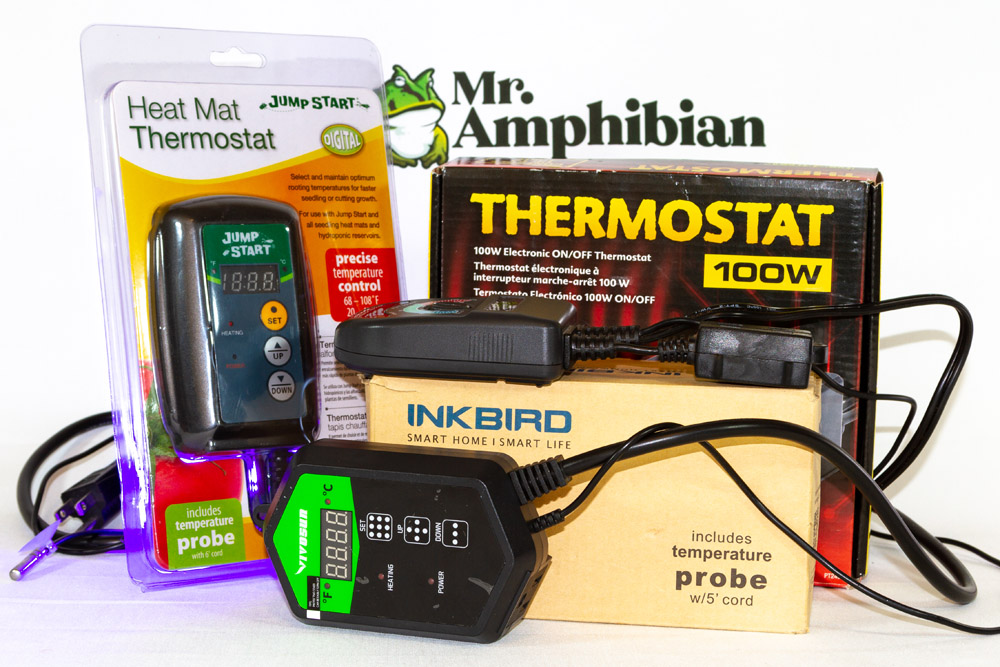
Thermostats are an important part of reptile and amphibian husbandry. Maintaining the correct temperature range within your pet’s enclosure is key to keeping them happy and healthy.
With a large number of thermostats available, it can be difficult to find the right product for you. One needs to sift through customer reviews and determine if it’s accurate and has the features you need.
That’s why I’ve put together a list of my favorites. I personally bought and tested these thermostats in order to create an accurate buyer’s guide for you.
Each thermostat here is popular in the herptile community and costs $60 or less. Four of them range in price from about $20 to $45, take or give a few dollars.
Directly below this paragraph is a small outline for each thermostat. Below the outline, you can learn how I tested and compared them.
Best Overall
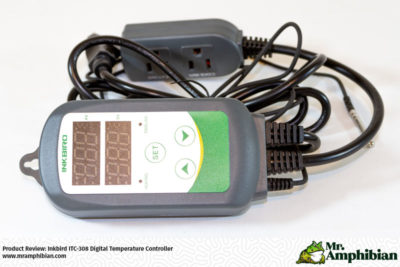
- Heating & Cooling
- Most Tech
- Highest Quality
Runner-up
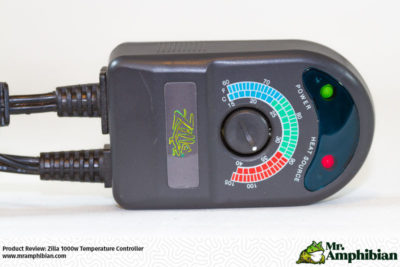
- Most Receptacles
- Easy to Use
- High Quality
Not Bad
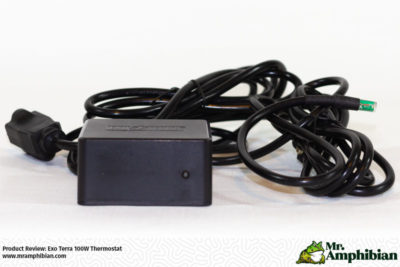
- High Quality
- Longest Cords
- Easy to Use
Classic
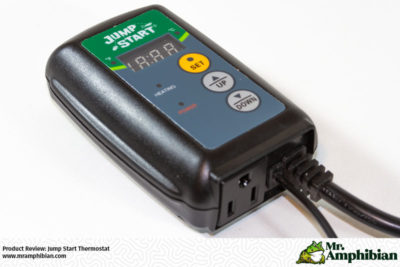
- High Quality
- Easy to Use
- For Heat Mat
Budget-friendly
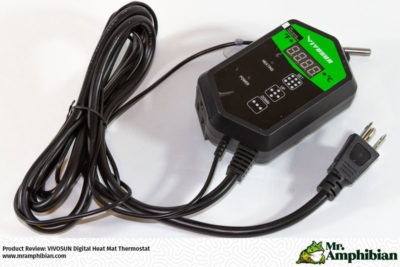
- Lowest Price
- Easy to Use
- For Heat Mat
Table of Contents
How I Tested The Thermostats
I’ve used several of these thermostats for different species over the years. The Zilla thermostat, for example, I’ve had more than 10 years. The Exo Terra 100w is fairly new to me but I feel I’ve had plenty of time to test and review it.
Regardless, I’ve put them to the test in a number of different ways. One of the ways you can visualize is by using the comparison table in the next section.
Comparing The Specifications
The table below lists every specification I could think to list. Most of the information I pulled directly from the units themselves. The Inkbird, Exo Terra, Jump Start, and VIVOSUN thermostats have some specs listed on the back.
The Zilla thermostat is very old and no specs were listed on the unit. I gathered the missing information online, to the best of my ability.
Things like the power cable length and probe cable length I collected from measuring the thermostats. Also, I got the wire gauge size from the cords on each.
| Inkbird | Zilla | Exo Terra | Jump Start | VIVOSUN | |
|---|---|---|---|---|---|
| Model | ITC-308 | 1000w Analog | 100w / PT2456 | MTPRTC | Thermostat |
| Style | ON/OFF | ON/OFF | ON/OFF | ON/OFF | ON/OFF |
| Type | Digital | Analog | Analog | Digital | Digital |
| Warranty | 1 Year | 1 Year | 1 Year | ||
| Min Temp | -58 °F | 60 °F | 68 °F | 68 °F | 68 °F |
| Max Temp | 248 °F | 105 °F | 95 °F | 108 °F | 108 °F |
| Max Wattage | 1000 | 1000 | 100 | 1000 | 1000 |
| Temp Accuracy | +/- 1 °F | * | * | * | * |
| Input | 100-240v, 50/60Hz | 120v / 60Hz | 120v / 60Hz | 120v / 60Hz | 120v / 60Hz |
| Output | 100-240v, 50/60Hz | 120v / 60Hz | 120v / 60Hz | 120v / 60Hz | 120v / 60Hz |
| Max Current | 10A | 8.3A | 1A | 8.3A | 8.3A |
| ETL Listed* | No | Yes | Yes | Yes | No |
| Waterproof probe | No* | Yes | Yes | No | No |
| Probe Cord Length | 75″ | 69″ | 77″ | 70″ | 76″ |
| Power Cord Length | 57″ | 72″ | 75″ | 72″ | 70″ |
| Power Cord AWG* | 16 | 16 | 16 | 16 | 18 |
| Heat Receptacles | 1 | 3 | 1 | 1 | 1 |
| Cool Receptacles | 1 | 0 | 0 | 0 | 0 |
| Similar Versions?* | Yes | Yes | Yes | No | No |
| Wifi | No* | No | No | No | No |
| Inkbird | Zilla | Exo Terra | Jump Start | VIVOSUN |
For the specs with a * – here is your reference guide:
- Temperature Accuracy – This refers to the accuracy of the temperature sensor. Only Inkbird lists an accuracy range (that I can find). +/- 1 degree means the sensor is accurate within 1 degree of temperature.
- ETL Listed – Products with the ETL mark means it complies with North American safety standards.
- AWG – Stands for American Wire Gauge and it measures the diamter of the wire. The higher the number, the smaller the wire is.
- Waterproof Probe – The Inkbird thermostat has a * because they have an ITC-308 version with a waterproof probe. All other probes are considered “water-resistance” and should not be submerged under water.
- Similar Versions – This refers to the brand and whether or not they have a similar version. For example, Exo Terra has a 100w, 300w, and 600w version of the their thermostat. Only one version is tested here.
- Wifi – The devices here don’t have wifi capabilities. However, Inkbird has a version with wifi and a smart app to control the thermostat.
More About Thermostats & How To Pick The Right One
Thermostats come in different types, shapes, and sizes. They’re used for various purposes. The most popular uses are in reptile/amphibian husbandry, gardening, and brewing.
Some have digital displays while others have analog dials. Listed below are the differences.
- Digital – These have a digital screen that displays the current temperature at the probe. Also, you program the desired temperature using the display and buttons on the unit.
- Analog – I consider these “old-school” but they’re simple to use and just as reliable as their digital counterparts. These thermostats have a dial you use to set the desired temperature.
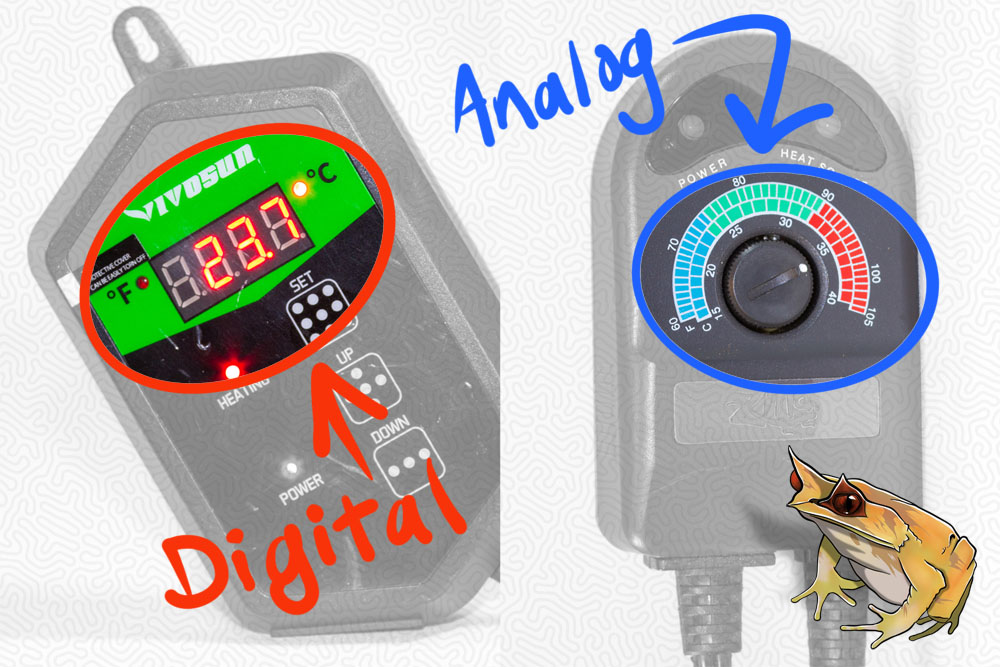
Types of Thermostats
Aside from the display, there are two main types of thermostats and they work in different ways. They’re often referred to as “ON/OFF” or “Proportional”.
Both types have different ways of regulating the heating element.
“ON/OFF” Thermostats
An ON/OFF thermostat works by turning the heating element on or off depending on the temperature in the enclosure.

The temperature sensor or “probe” reports the current temperature to the thermostat. If the temperature at the probe is less than the desired temperature, the thermostat turns the heater on.
Likewise, if the temperature at the probe is above the desired temperature, the thermostat turns the heater off.
ON/OFF thermostats tend to work best with heat mats/pads. They can be used with ceramic heat emitters or bulbs but they’re most accurate with under-tank heaters.
Proportional Thermostats
A proportional thermostat regulates the amount of power going to the heating device. It does not turn the heating element on or off. These thermostats restrict voltage to the heater in order to produce less heat. Increasing the voltage allows the heater to produce more heat.

Two types of proportional thermostats:
- Pulse – Sends pulses of energy to the heating device. Longer pulses allow the heater to produce more heat.
- Dimming – Restricts power going to the heater until a consistent temperature is established.
Proportional thermostats are more accurate than ON/OFF thermostats because they’re able at hold a consistent temperature. They’re more sophisticated, often used for incubating eggs.
Picking The Right Thermostat For Your Setup
ON/OFF thermostats are less expensive than proportional thermostats. There are proportional thermostats on this list because we’re comparing some of the best thermostats under $60.
If you need a highly accurate thermostat, one capable of holding the temperature within a one-degree margin, I encourage you to research proportional thermostats. HerpStat[1] or Vivarium Electronics[2] are two of the best brands.
For everyone else, ON/OFF thermostats tend to be accurate within +/- 5 degrees Fahrenheit. That means if you set the temperature to 80 degrees, the thermostat should keep the temperature between 77.5 to 82.5 degrees. Most reptiles and amphibians do well in this range.
Things to consider when choosing a thermostat:
- Temperature accuracy range
- How many heating elements you need
- Your budget
- Should the thermostat also control a cooling device (a fan)
- The length of the cords
- Does the temperature sensor need to be water proof (submerged in water)
All of these things should be considered when selecting the best thermostat for your pet’s enclosure. Feel free to use the specs comparison table above to help you make a decision.
Review: The 5 Best Reptile Thermostats
Now that you know what to look for in a thermostat for your reptile or amphibian enclosure, let’s get to the main part of this guide. Keep in mind, the best thermostat for you depends on your setup requirements.
I will give my personal recommendation, based on my experience and comparison of features, but ultimately, you have to decide which is best for you. I hope this guide is beneficial and helps you make an informed decision!
Inkbird ITC-308
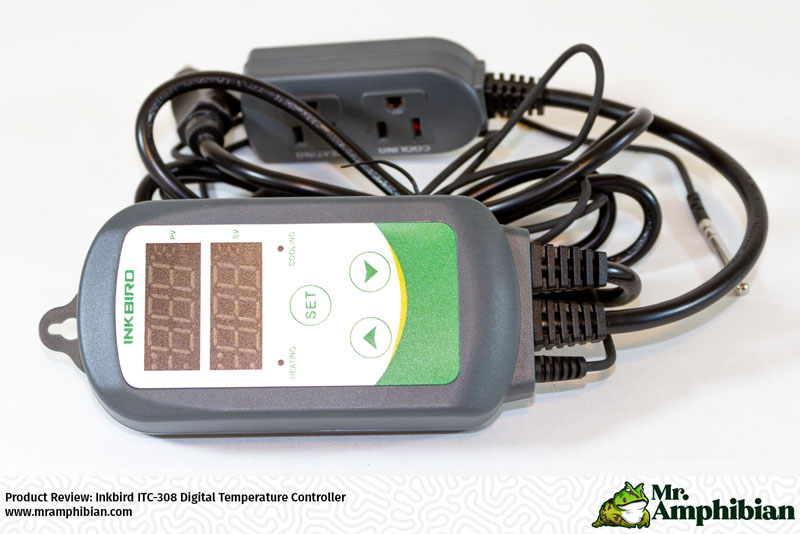
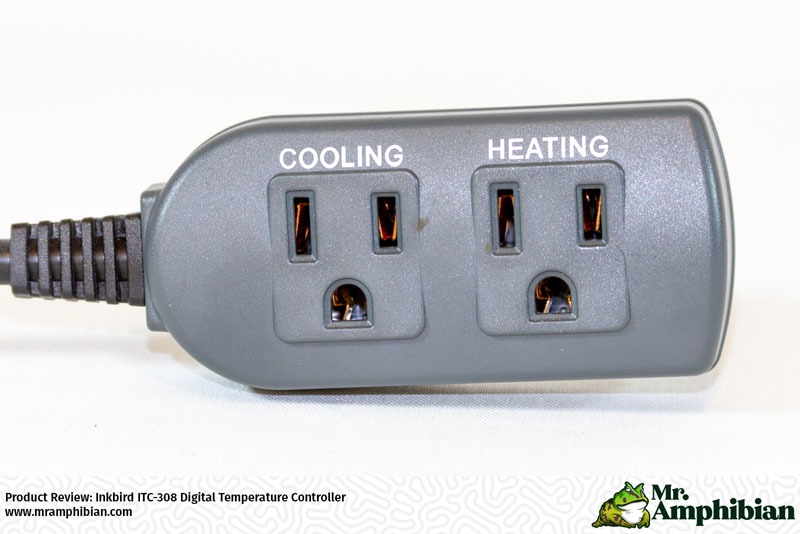
My personal favorite and #1 recommended thermostat is the Inkbird ITC-308. It has the most tech out of the five thermostats in this review but that alone wasn’t the reason I like it the most.
It has the best accuracy and the largest temperature range. Why is this important? Well, accuracy is obviously important for keeping the temperature within a narrow range. For certain species, this is more important than others.
The temperature range is also important. Most frogs don’t require heat above 100 degrees Fahrenheit but some reptiles do. For the handful of reptile species needing daytime temperatures above 110 °F, this is your best option.
Pros
- Best Accuracy
- Offers heating & cooling control
- Best temperature range
- Handles up to 1000 watts
- 1 Year Warranty
Cons
- More complicated setup compared to the others
It’s worth mentioning that the ITC-308 has the shortest cord length by roughly 1 foot. Regardless, the length is more than adequate for most setups and it shouldn’t keep you from choosing this.
Also, Inkbird has an upgraded version of the ITC-308 with WiFi. It comes with a smart app that allows you to monitor the temperature, view the history, and program the device. I have not personally tested the WiFi version but plan to in the near future. If this is something you’re interested in, I’ve provided a link below.
In addition to this, Inkbird offers different probe options [3]. They have a version with a waterproof probe.
Finally, the cooling receptacle might go unused in most reptile or amphibian habitats but it’s a nice feature to have available.
I highly recommend the Inkbird ITC-308. It offers the best accuracy, most tech, and it’s made with quality materials. To learn more and purchase one for yourself, please use the links below.
Zilla 1000w Thermostat
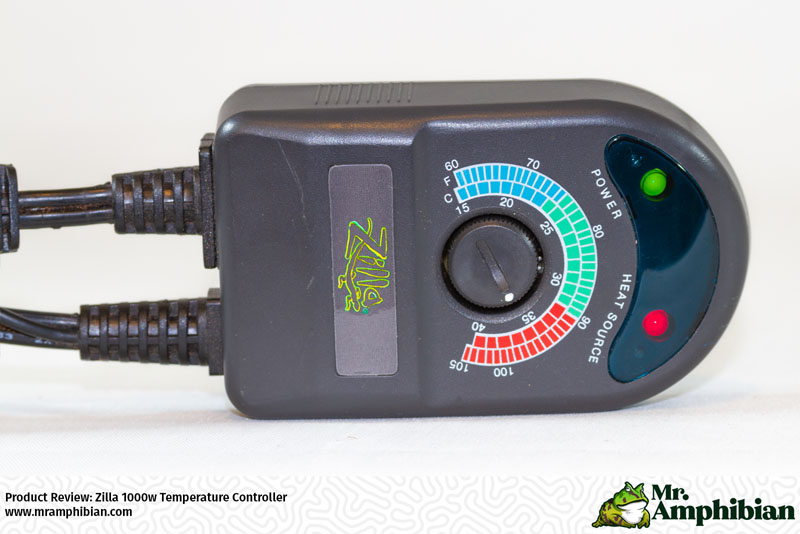
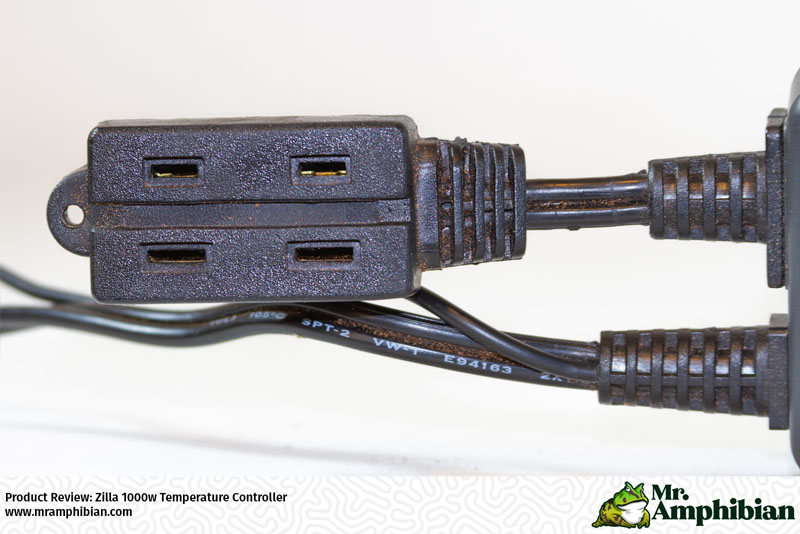
I had a hard time placing Zilla’s thermostat as the runner-up. It has one feature I wish the ITC-308 had; multiple heater receptacles. It’s not uncommon for reptile/amphibian habitats to use two heaters. This feature is lacking in the other thermostats in this buyer’s guide.
Keep in mind, one should not attempt to use a single thermostat for different enclosures. After all, there is only one temperature probe. Regardless, having two heaters for a single, large reptile enclosure is sometimes required.
Pros
- 3 heating receptacles
- Handles up to 1000 watts
- 1 Year Warranty
- Easy to use
- Decent temperature range
Cons
- Analog version is hard to find
- Most expensive
Aside from having the ability to control multiple heaters, the Zilla thermostat is incredibly easy to use. The analog dial on the front is used to set the temperature. Simply place the probe, set the temperature, plug in the heater(s), and you’re good to go.
Zilla has an updated version, a digital thermostat[4]. It has much of the same qualities as the older version. The difference is that you set the desired temperature using the digital display and buttons. It’s easier to find, as it’s still in production. For that reason, I’ll leave a link to it below.
If you’re able to find the 1000w analog version of Zilla’s thermostat, get it. I’ve owned one for years and it works great.
VIVOSUN Thermostat
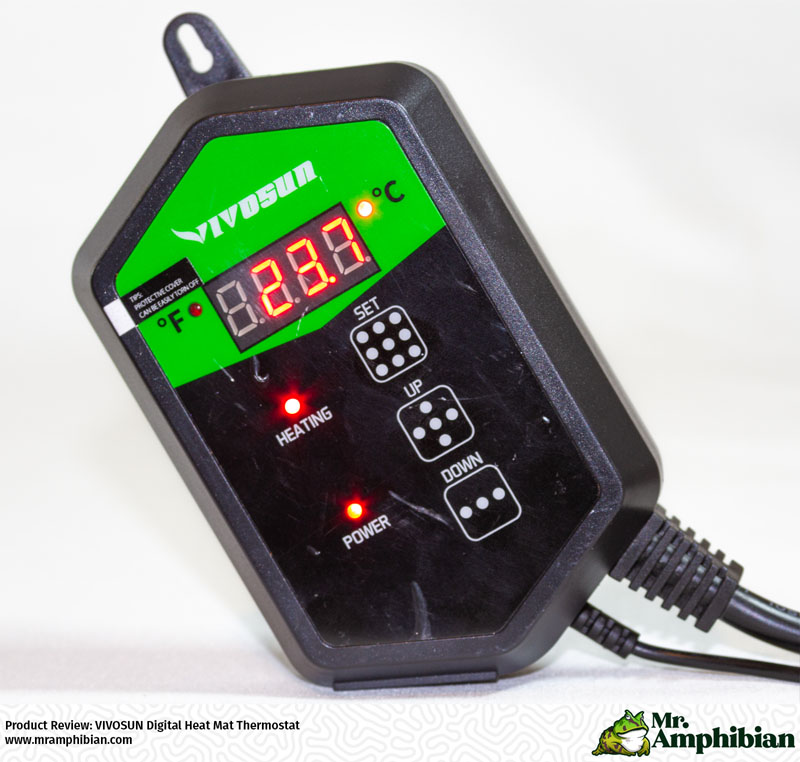
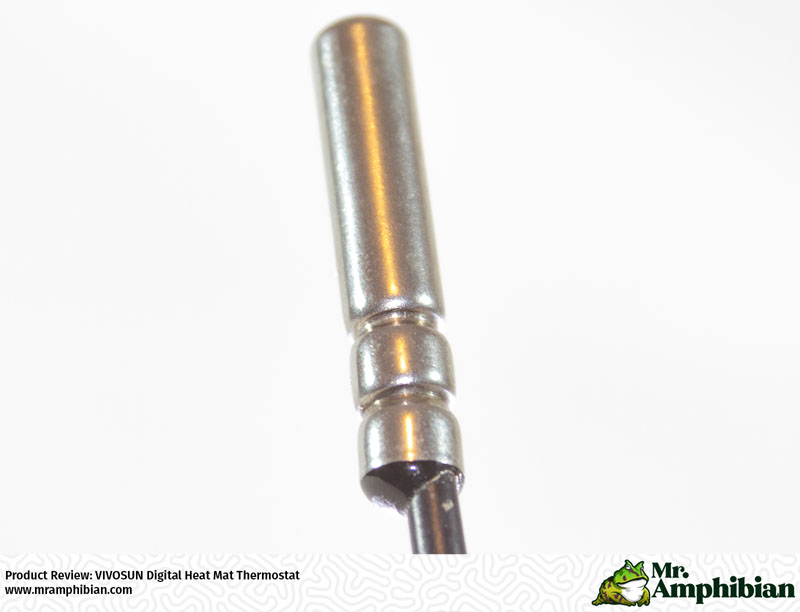
For budget builds or those entering the herptile hobby for the first time, the VIVOSUN thermostat is a great place to start. It offers an easy to use, digital display and allows you to control one heating device.
I’ve had the VIVOSUN thermostat for several months and using it is super simple. Holding the “SET” button for a few seconds allows you to enter the programming mode where you can set the temperature by using the UP/DOWN arrows.
When you’re not in the programming mode, simply press the UP or DOWN button to switch between Fahrenheit and Celcius[5].
Pros
- Least Expensive
- Easy to use
- Handles up to 1000 watts
- Decent temperature range
Cons
- Lowest quality
Cheaper devices usually come with a trade-off; quality. In this case, the overall quality isn’t much different from the other thermostats here. The main difference comes in the gauge of the power cable.
The VIVOSUN thermostat utilizes an 18 gauge power cord whereas the others use 16 gauge. This might sound better at first but, the higher the gauge, the smaller the diameter of the wire.
Despite its minor shortcomings, the VIVOSUN thermostat is a great option for budget builds and first-time reptile or amphibian hobbyists. It’s great for small enclosures using a heat mat.
Exo Terra 100w Thermostat
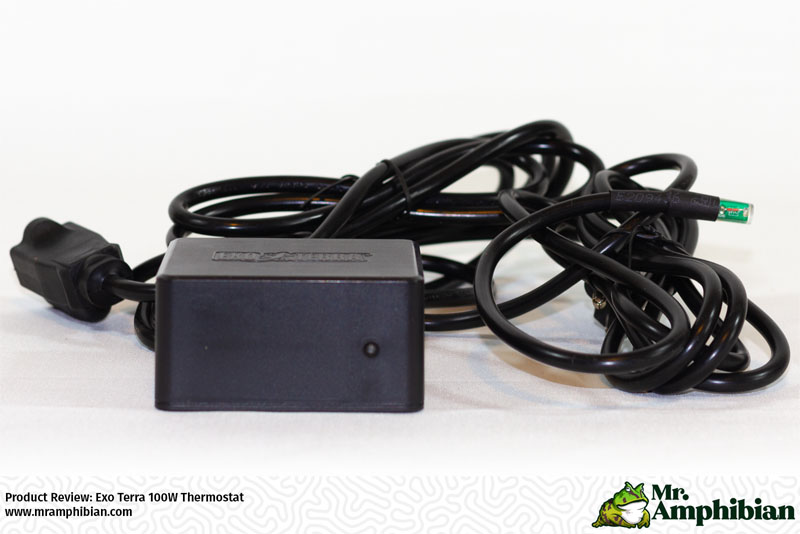
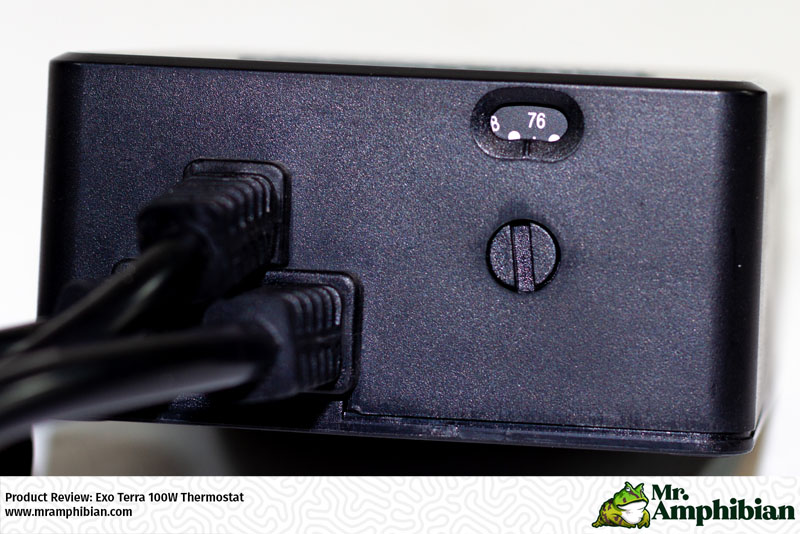
Exo Terra delivered a quality product in the form of their 100w thermostat. It’s a nice, high-quality product that’s competitively priced. One of the reasons I like this thermostat is because the temperature sensor cable uses 16 gauge wire. That’s something the other thermostats don’t do.
Unfortunately, the heavy wire can be considered a downside. It’s a stiff cord and it can be difficult to work with! It might seem like I’m complaining but seriously, it’s more difficult to work with than all the other thermostats.
Pros
- Waterproof temperature probe
- Easy to Use
- Quality materials
- Lengthy power cables
Cons
- Sensor probe cord is difficult to work with
- Below average temperature range
It’s an analog thermostat with a temperature dial on the back. The dial is easy to set. I was able to turn it with my fingernail, but a screwdriver works as well. Another cool feature is that the temperature sensor is completely waterproof.
I’ll briefly go over Exo Terra’s different thermostat versions[6]. They offer a 300w version and a 600w version. The 300w version is basically the same as this one but has the capacity to safely control up to 300 watts. The 600w version is quite different. It’s a proportional thermostat with two receptacles and a day/night timer. It’s also more expensive.
Jump Start Thermostat
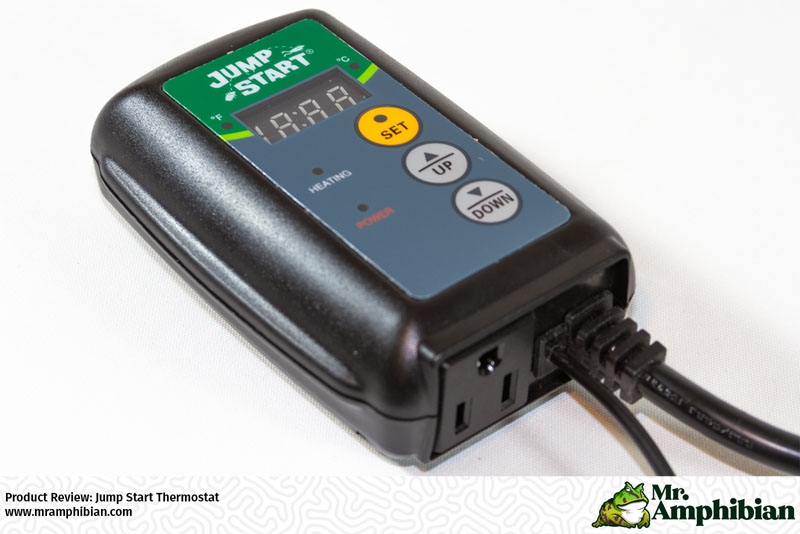
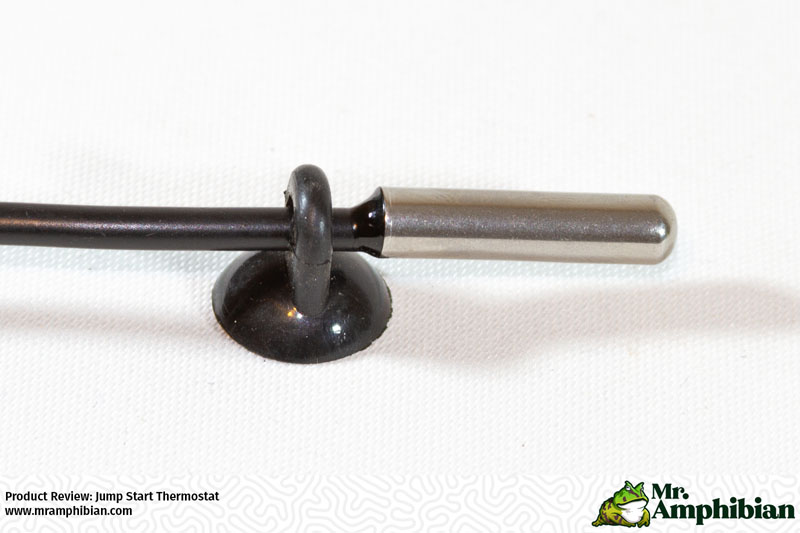
Jump Start’s thermostat[7] is an instant classic. The reason it doesn’t rank higher on the list is due to the price.
Don’t get me wrong, the Jump Start thermostat is great and it’s made from quality materials. Moreover, it has a solid reputation in the reptile/amphibian community. It’s highly recommended and has great reviews.
However, you can get the same quality plus more features in the ITC-308, and for a cheaper price. This is the reason it ranks so low in my review.
Pros
- Easy to use
- Quality materials
- Controls up to 1000 watts
- 1 Year warranty
Cons
- Slightly expensive for the features
I struggled to come up with cons for this particular item. The only real downside to Jump Start’s thermostat is that you can get the same features for nearly half the price compared to VIVOSUN. The quality is better here, but if quality and features are what you’re after, you can buy the ITC-308 for roughly the same price, or slightly less.
TLDR; Which Thermostat is Best For Reptile/Amphibian Enclosures?
Thermostats play an important role in reptile and amphibian husbandry. They regulate heating and cooling elements in order to maintain a specific temperature range within your pet’s enclosure.
There is an overwhelming number of thermostats on the market and finding the right one for you depends on your setup. Here is a recap of my picks for the best reptile thermostats:
- The Inkbird ITC-308 is my #1 favorite because it’s the most accurate, has the most features, great quality, and it’s reasonably priced.
- My runner-up is Zilla’s thermostat due to its overall quality and it has 3 heating receptacles.
- The budget-friendly option is VIVOSUN’s thermostat. It offers many of the same features as the other products, but costs nearly half the price.
By the way, I created more in-depth reviews for each of the thermostats on this page. You can find them in the reviews section using the menu. Feel free to explore those pages for more information.
This concludes my buyer’s guide for the 5 best thermostats for reptile and amphibian enclosures under $60. I spent a lot of time and effort creating this page and I truly hope you found it helpful. I plan to keep expanding this guide as I buy and test more thermostats.
Please, leave a comment below if you have any questions, suggestions, or feedback!
References
- Direct, Spyder Robotics. “Temp and Humidity Controllers : Spyder Robotics LLC.” Spyder Robotics, https://spyderrobotics.com/index.php?main_page=index&cPath=1. Accessed 30 Dec. 2021.[↩]
- “Vivarium Electronics.” Vivarium Electronics, https://vivariumelectronics.com. Accessed 30 Dec. 2021.[↩]
- “Inkbird Global Store | Smart Home, Smart Life.” Inkbird, inkbird.com. Accessed 30 Dec. 2021.[↩]
- “Digital Temperature Controller | Lighting and Heating | Zilla.” Zilla Rules, www.zillarules.com/all-products/lighting-heating/digital-temperature-controller. Accessed 30 Dec. 2021.[↩]
- “VIVOSUN Seedling Heat Mat Thermostat.” VIVOSUN, vivosun.com/products/vivosun-digital-heat-mat-thermostat-temperature-control-for-seedlings-germination-rooting-fermentation-and-reptiles. Accessed 30 Dec. 2021.[↩]
- “Exo Terra : Thermostats.” Exo Terra, www.exo-terra.com/en/products/thermostats-100W-300W.php. Accessed 30 Dec. 2021.[↩]
- “Jump Start Digital Temperature Controller for Heat Mats.” Hydrofarm, www.hydrofarm.com/p/jump-start-digital-temperature-controller-for-heat-mats/mtprtc. Accessed 30 Dec. 2021.[↩]
